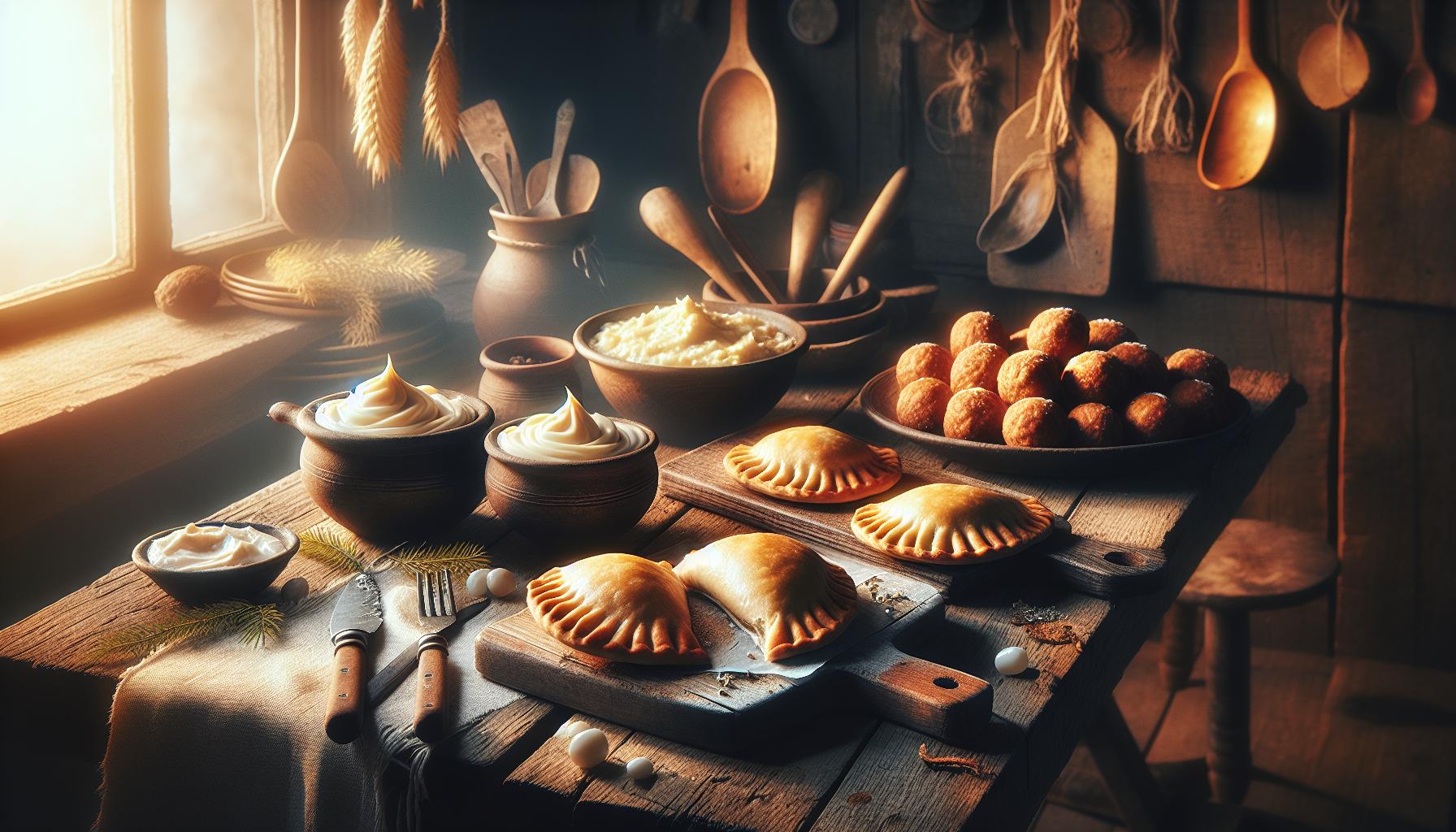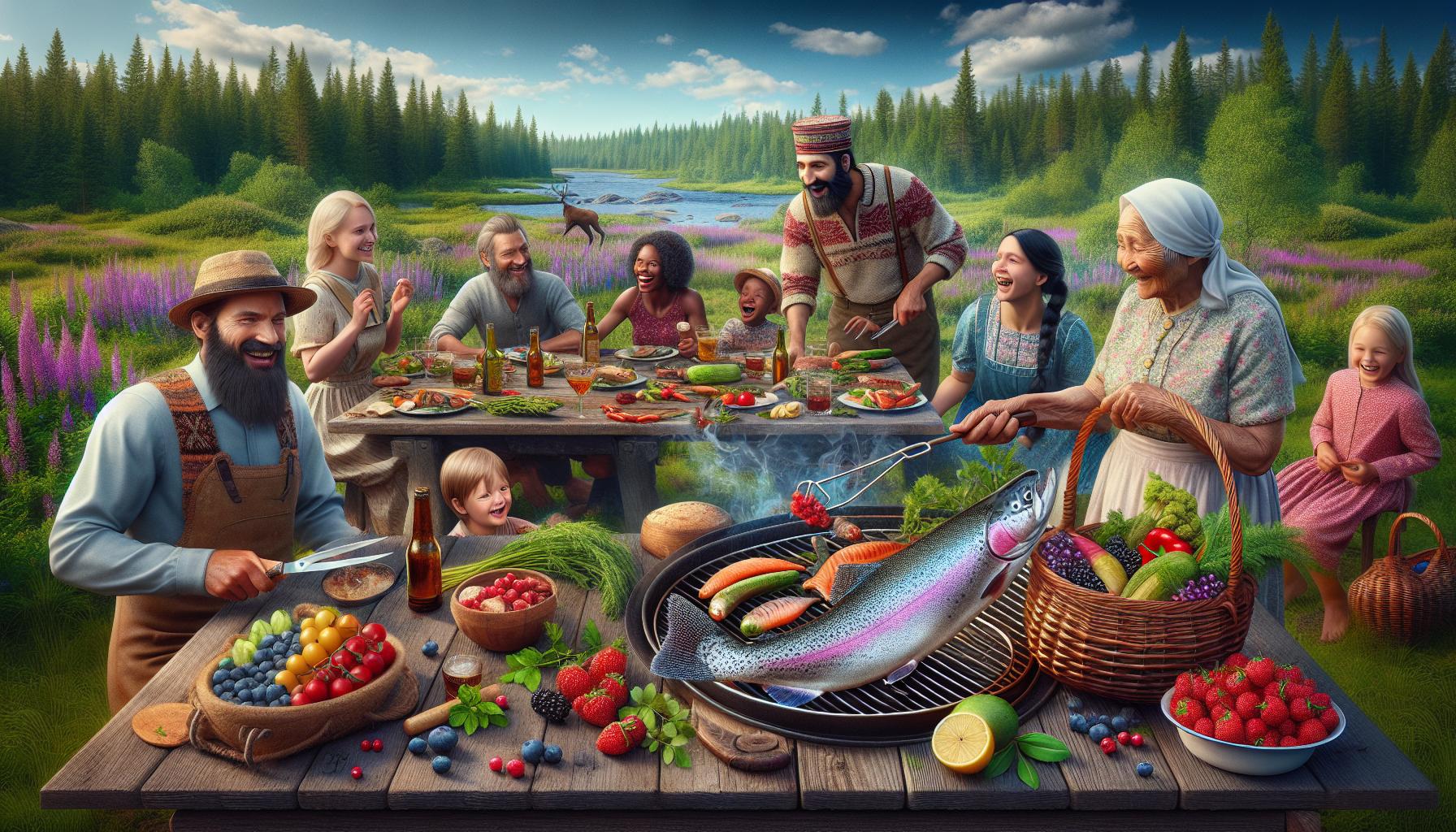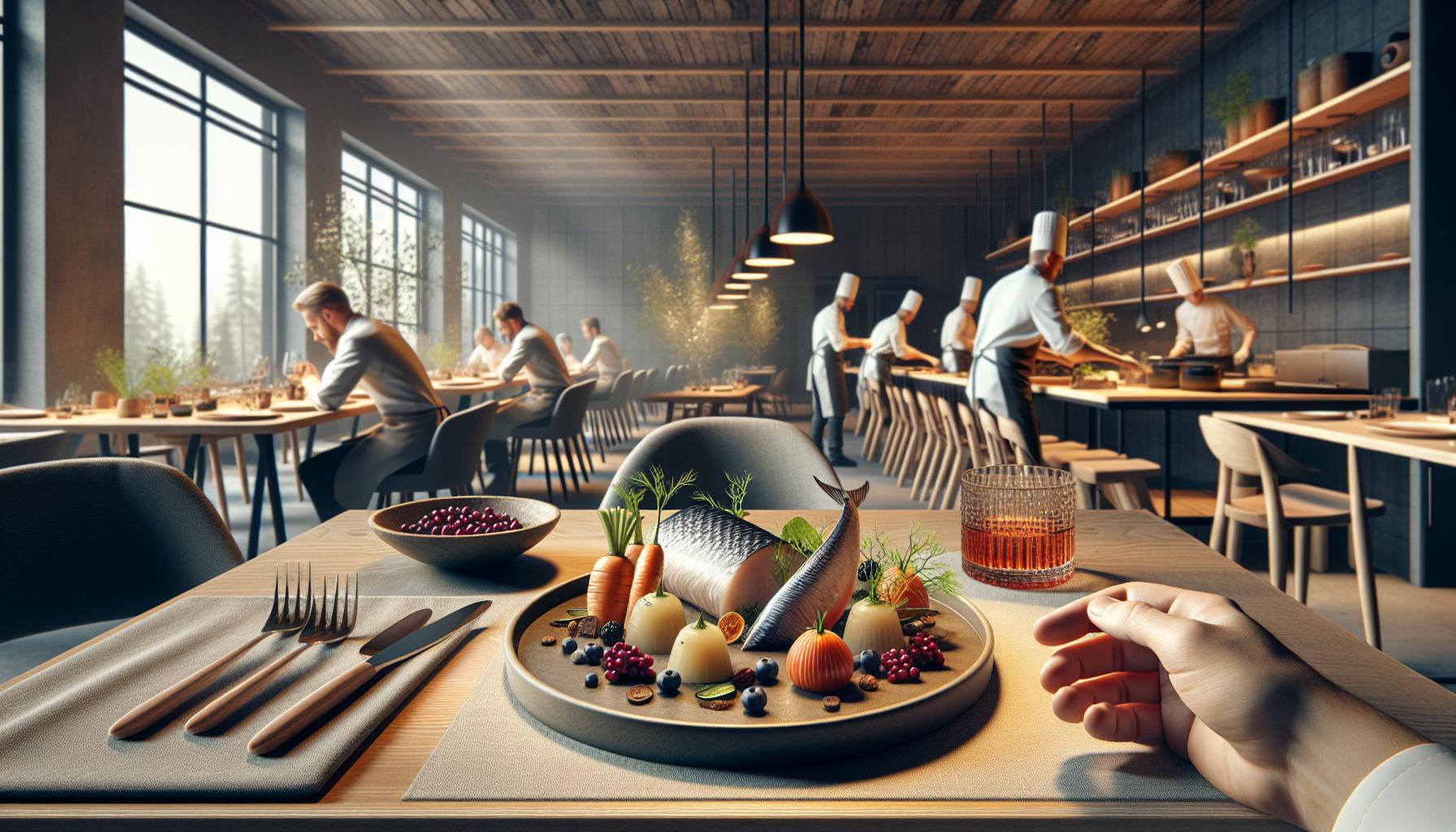Finnish cuisine tells a delightful story of pristine forests, crystal-clear lakes, and hardy Nordic traditions. From the smoky essence of grilled salmon to the comforting warmth of karjalanpiirakka (Karelian pasties), Finland’s food culture reflects its unique position as a crossroads between Eastern and Western culinary influences.
In this land where the midnight sun meets endless winter nights, Finns have mastered the art of transforming simple, local ingredients into extraordinary flavors. They’ve embraced the “forest-to-table” concept long before it became a global trend, turning wild berries, mushrooms, and game meat into celebrated national dishes. It’s a cuisine that’s both rustic and refined, telling tales of survival, innovation, and pure culinary joy.
Finland Food Culture
Finnish cuisine celebrates ingredients sourced directly from nature’s pantry. The country’s pristine forests lakes mountains contribute an array of distinctive flavors to traditional dishes.
Berries, Mushrooms and Wild Game
Finland’s forests offer an abundant variety of wild berries including lingonberries cloudberries blueberries. Foragers collect over 50 edible mushroom species such as chanterelles porcini morels during autumn months. Wild game features prominently in Finnish cooking with elk reindeer wood grouse providing lean protein sources. Local chefs incorporate these ingredients into modern interpretations of classic dishes:
- Lingonberry jam accompanies meat dishes year-round
- Chanterelle soup emerges as a seasonal autumn favorite
- Reindeer fillets serve as the centerpiece in fine dining
- Cloudberry preserves add tartness to traditional desserts
Fish and Seafood Specialties
Finnish waters yield diverse freshwater fish including pike perch whitefish arctic char. The Baltic Sea contributes salmon herring to the coastal cuisine. Traditional preservation methods like smoking salting drying extend the shelf life of seafood catches. Popular preparations include:
- Graavilohi (cured salmon) served with dill mustard sauce
- Savulohi (smoked salmon) enjoyed on dark rye bread
- Fried Baltic herring appears as a lunch staple
- Fish soup combines various local catches with root vegetables
All these ingredients integrate seamlessly into both rustic home cooking refined restaurant menus throughout Finland.
Iconic Finnish Dishes and Delicacies

Finland’s culinary landscape features distinctive dishes that reflect its cultural heritage and natural resources. These iconic recipes showcase the artistry of Finnish cooking through simple ingredients transformed into beloved national treasures.
Karjalanpiirakka (Karelian Pasties)
Karjalanpiirakka stands as Finland’s most recognized pastry, combining a thin rye crust with a creamy rice porridge filling. The oval-shaped pasties measure 3-4 inches in length and feature distinctive crimped edges created by pinching the dough. Modern variations incorporate potato, carrot or mushroom fillings, though traditional recipes strictly use the rice mixture. Finnish bakers serve these pasties warm with munavoi, a spread made from hard-boiled eggs mashed with butter. The Finnish government designated Karjalanpiirakka as a Traditional Specialty Guaranteed product in 2003, protecting its authentic preparation methods.
Lihapullat (Finnish Meatballs)
Finnish meatballs feature a distinctive blend of ground beef, pork and onions seasoned with allspice, nutmeg and white pepper. The meat mixture contains fresh breadcrumbs soaked in milk, creating a tender texture unique to Nordic preparations. Cooks form the seasoned meat into 1-inch spheres and pan-fry them until golden brown. Traditional accompaniments include creamy mashed potatoes, lingonberry jam and brown gravy. Finnish families serve lihapullat at holiday gatherings, particularly during Christmas and Midsummer celebrations. Many restaurants across Finland offer their own interpretations, ranging from classic recipes to modern variations with local game meats.
The Role of Seasons in Finnish Cuisine

Finnish cuisine changes dramatically with the seasons, reflecting the country’s extreme climate variations. Each season brings distinct ingredients and cooking methods that shape the traditional food culture.
Summer Food Traditions
Summer in Finland transforms dining into an outdoor celebration with fresh local produce. Finns embrace grilling culture, cooking fish like rainbow trout and whitefish over open fires at summer cottages. Wild berries become abundant, with locals collecting lingonberries, cloudberries, blueberries from forests for immediate consumption or preservation. Traditional summer dishes include new potatoes with dill, fresh garden peas, and grilled sausages. Restaurants serve light, cold soups like kesäkeitto made with fresh vegetables and herbs. Food markets overflow with locally grown strawberries, cucumbers, tomatoes during the brief but intense growing season.
Winter Comfort Foods
Finnish winters inspire hearty, warming dishes that provide sustenance during long dark months. Traditional winter favorites include karjalanpaisti, a slow-cooked stew combining multiple meats with root vegetables. Families gather around steaming bowls of hernekeitto (pea soup) served with rye bread every Thursday. Hot porridges made from rye, barley or oats start winter mornings, often topped with lingonberry jam or butter. Bakeries produce seasonal treats like korvapuusti (cinnamon rolls) and laskiaispulla (cream-filled buns) to combat winter blues. Root vegetables like turnips, carrots, rutabagas feature prominently in casseroles called laatikko, essential components of winter holiday tables.
Modern Finnish Food Culture

Finnish cuisine has evolved into a dynamic blend of traditional methods with contemporary techniques. The modern food scene emphasizes local ingredients while embracing global influences.
Contemporary Nordic Cuisine
Modern Finnish chefs reimagine traditional ingredients through innovative cooking methods. Local restaurants showcase pure flavors using molecular gastronomy techniques with foraged ingredients like wild herbs, berries, and mushrooms. The New Nordic Food movement promotes sustainable practices, incorporating zero-waste principles and seasonal produce. Finnish kitchens feature fermentation techniques, smoking methods, and preservation practices that combine ancestral wisdom with modern food science. Restaurants elevate simple ingredients like Baltic herring, rutabaga, and lingonberries into sophisticated dishes that attract international attention.
Restaurant Scene and Food Innovation
Helsinki leads Finland’s culinary revolution with 6 Michelin-starred restaurants as of 2023. Food halls, street markets, and pop-up dining experiences transform urban areas into gastronomic destinations. Finnish chefs experiment with plant-based alternatives, creating innovative dishes using local ingredients like oats, peas, and hemp. Restaurant Day, a quarterly food carnival, enables home cooks to operate pop-up restaurants throughout Finnish cities. Food technology startups develop sustainable protein sources, including lab-grown meat alternatives and insect-based products. Finnish restaurants prioritize transparency by displaying ingredient origins, carbon footprints, and sustainability practices on their menus.
Finnish Dining Customs and Etiquette
Finnish dining customs reflect a blend of formal European traditions and relaxed Nordic sensibilities. These practices emphasize respect for food, appreciation of shared meals and punctuality.
Traditional Mealtimes
Finnish daily meals follow a structured schedule that begins with aamiainen (breakfast) between 7-9 AM. Lounas (lunch) occurs from 11 AM-1 PM, serving as the main meal in workplaces and schools. Päivällinen (dinner) takes place between 5-7 PM, featuring hot dishes shared with family. Many Finns enjoy illallinen (supper) around 8 PM, consisting of light fare like sandwiches or leftovers. Coffee breaks called kahvitauko punctuate the day at 10 AM and 2 PM, accompanied by pulla (sweet bread) or other pastries.
Social Dining Practices
Finnish hosts extend dinner invitations at least one week in advance with guests arriving precisely on time. Removing shoes at the entrance demonstrates respect in Finnish homes. Diners wait for the host’s “hyvää ruokahalua” (good appetite) before starting their meal. Table manners include keeping hands visible on the table, eating with a knife and fork, and finishing all food on the plate. Guests express gratitude by saying “kiitos ruuasta” (thanks for the food) after meals. Business meetings often combine dining with sauna sessions, creating informal networking opportunities.
The Coffee Culture of Finland
Finland ranks as the world’s highest coffee consumer, with Finns drinking an average of 12 kg of coffee per person annually. Finnish coffee culture centers around light roasted coffee beans, producing a distinct bright flavor profile that sets it apart from other European coffee traditions.
Kahvitauko, the traditional Finnish coffee break, occurs multiple times throughout the day. These breaks serve as essential social rituals in both workplaces and homes, typically accompanied by pulla (cardamom-spiced sweet bread) or korvapuusti (cinnamon rolls).
| Finnish Coffee Statistics | Data |
|---|---|
| Annual consumption per person | 12 kg |
| Daily cups per person | 3-5 |
| Preferred roast type | Light |
| Daily coffee breaks | 2-3 |
Local coffee brands like Paulig Juhla Mokka dominate the Finnish market, reflecting national preferences for specific roasting profiles. Coffee preparation methods favor filter coffee over espresso-based drinks, with most homes equipped with traditional drip coffee makers.
Finnish coffee etiquette includes specific customs:
- Serving coffee immediately upon guests’ arrival
- Offering multiple refills throughout visits
- Pairing coffee with traditional pastries
- Using specific coffee cups for different occasions
The significance of coffee extends beyond casual consumption into formal celebrations:
- Wedding ceremonies feature elaborate coffee services
- Business meetings incorporate structured coffee breaks
- Academic celebrations include formal coffee gatherings
- Holiday traditions center around specific coffee-based customs
Finnish legislation guarantees workers’ rights to coffee breaks, cementing the beverage’s cultural importance. Modern coffee shops blend traditional Finnish coffee culture with contemporary café trends, maintaining the essential elements of communal coffee consumption while introducing new brewing methods.
Testament to the Nation’s Deep Connection
Finnish food culture stands as a testament to the nation’s deep connection with nature sustainability and innovation. From traditional foraging practices to modern Michelin-starred restaurants Finnish cuisine continues to evolve while maintaining its authentic roots.
The blend of time-honored recipes contemporary cooking techniques and a strong emphasis on local ingredients showcases Finland’s culinary prowess. The country’s commitment to sustainable practices seasonal eating and coffee culture reflects a broader lifestyle that values both tradition and progress.
Finnish gastronomy offers more than just sustenance – it’s an invitation to experience the country’s rich heritage pristine landscapes and warm hospitality through the lens of food.

